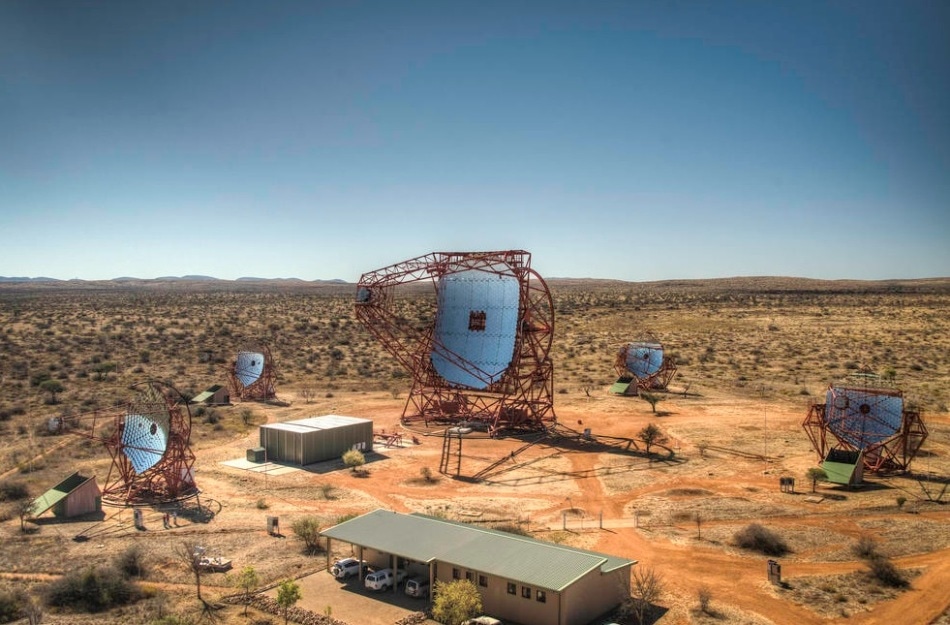Jul 19 2017
A collective study on the data obtained from NASA's Fermi Gamma-ray Space Telescope and the High Energy Stereoscopic System (H.E.S.S.), a ground-based observatory in Namibia, reveals that the center of the Milky Way comprises of a "trap" that is capable of concentrating some of the highest-energy cosmic rays, among the fastest particles present in the galaxy.
 The five telescopes of the High Energy Stereoscopic System (H.E.S.S.), located in Namibia, capture faint flashes that occur when ultrahigh-energy gamma rays are absorbed in the upper atmosphere. A new study of the galactic center combines high-energy observations from H.E.S.S. with lower-energy data from NASA's Fermi Gamma-ray Space Telescope to show that some of the speediest particles become trapped there. Credits: H.E.S.S., MPIK/Christian Foehr
The five telescopes of the High Energy Stereoscopic System (H.E.S.S.), located in Namibia, capture faint flashes that occur when ultrahigh-energy gamma rays are absorbed in the upper atmosphere. A new study of the galactic center combines high-energy observations from H.E.S.S. with lower-energy data from NASA's Fermi Gamma-ray Space Telescope to show that some of the speediest particles become trapped there. Credits: H.E.S.S., MPIK/Christian Foehr
"Our results suggest that most of the cosmic rays populating the innermost region of our galaxy, and especially the most energetic ones, are produced in active regions beyond the galactic center and later slowed there through interactions with gas clouds," stated lead author Daniele Gaggero at the University of Amsterdam. "Those interactions produce much of the gamma-ray emission observed by Fermi and H.E.S.S."
Cosmic rays are high-energy particles passing through space at a speed very much similar to that of light. Approximately 90% are protons, with the nuclei of various atoms and electrons making up the rest. While traveling across the galaxy, these electrically charged particles are impacted by magnetic fields, which modify their paths, making it impossible to know from where they originated.
However, it is possible for astronomers to gain knowledge about these cosmic rays when they relate with matter and release gamma rays, which are considered to be the highest-energy form of light.
Gamma-ray evidence of the intense activity in the galactic center was reported by scientists with the H.E.S.S. Collaboration in March 2016. The team discovered a diffuse glow of gamma rays reaching almost 50 trillion electron volts (TeV); that is about 50 times greater than the gamma-ray energies observed by Fermi's Large Area Telescope (LAT). In order to put these numbers in perspective, the energy obtained from the visible light ranges from about 2 to 3 electron volts.
Gamma rays are detected by the Fermi spacecraft when they enter the LAT. H.E.S.S. detects the emission on the ground when the atmosphere absorbs gamma rays, which activates a flow of particles leading to a flash of blue light.
An international team of scientists, in a recent analysis featuring in the July 17 issue of the journal Physical Review Letters, incorporated low-energy LAT data with high-energy H.E.S.S. observations. A continuous gamma-ray spectrum was the outcome describing the galactic center emission across a thousandfold span of energy.
"Once we subtracted bright point sources, we found good agreement between the LAT and H.E.S.S. data, which was somewhat surprising due to the different energy windows and observing techniques used," stated co-author Marco Taoso at the Institute of Theoretical Physics in Madrid and Italy's National Institute of Nuclear Physics (INFN) in Turin.
This agreement points out that the same population of cosmic rays — frequently protons — detected throughout the rest of the galaxy is indeed responsible for gamma rays viewed from the galactic center. However, the highest-energy share of these particles, referring to those reaching 1,000 TeV, move via the region in a less efficient manner than they do elsewhere in the galaxy. This leads to a gamma-ray glow reaching to the highest energies H.E.S.S. has ever observed.
"The most energetic cosmic rays spend more time in the central part of the galaxy than previously thought, so they make a stronger impression in gamma rays," said co-author Alfredo Urbano at the European Organization for Nuclear Research (CERN) in Geneva and INFN Trieste.
This effect is not incorporated in standard models of how cosmic rays travel via the galaxy. The researchers however demonstrate that simulations with this change reveal a much better agreement with Fermi data.
"The same breakneck particle collisions responsible for producing these gamma rays should also produce neutrinos, the fastest, lightest and least understood fundamental particles," said co-author Antonio Marinelli of INFN Pisa. Neutrinos move straight to humans on Earth from their sources since they hardly interact with other matter and also because they do not carry electrical charge, so magnetic fields need not sway them.
"Experiments like IceCube in Antarctica are detecting high-energy neutrinos from beyond our solar system, but pinpointing their sources is much more difficult," stated Regina Caputo, a Fermi team member at NASA's Goddard Space Flight Center in Greenbelt, Maryland, who was not involved in the study. "The findings from Fermi and H.E.S.S. suggest the galactic center could be detected as a strong neutrino source in the near future, and that's very exciting."
The Fermi mission is an astrophysics and particle physics partnership, launched by NASA in association with the U.S. Department of Energy, along with vital contributions from academic institutions and partners in France, Germany, Japan, Italy, the United States and Sweden. The H.E.S.S. Collaboration includes scientists from Germany, France, Poland, the Czech Republic, Ireland, the United Kingdom, South Africa, Armenia and Namibia.